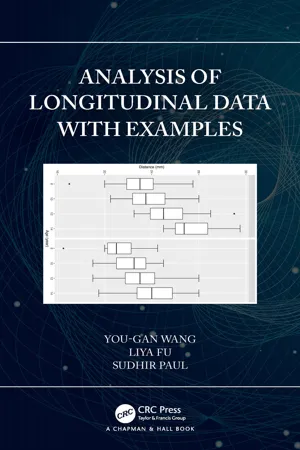
- 248 pages
- English
- ePUB (mobile friendly)
- Available on iOS & Android
Analysis of Longitudinal Data with Examples
About This Book
Development in methodology on longitudinal data is fast. Currently, there are a lack of intermediate /advanced level textbooks which introduce students and practicing statisticians to the updated methods on correlated data inference. This book will present a discussion of the modern approaches to inference, including the links between the theories of estimators and various types of efficient statistical models including likelihood-based approaches. The theory will be supported with practical examples of R-codes and R-packages applied to interesting case-studies from a number of different areas.
Key Features:
•Includes the most up-to-date methods
•Use simple examples to demonstrate complex methods
•Uses real data from a number of areas
•Examples utilize R code
Frequently asked questions
Information
Chapter 1 Introduction
1.1 Longitudinal Studies
Table of contents
- Cover Page
- Half-Title Page
- Title Page
- Copyright Page
- Dedication Page
- Contents
- List of Figures
- List of Tables
- Preface
- Author Bios
- Contributors
- Acknowledgment
- 1 Introduction
- 2 Examples and Organization of The Book
- 3 Model Framework and Its Components
- 4 Parameter Estimation
- 5 Model Selection
- 6 Robust Approaches
- 7 Clustered Data Analysis
- 8 Missing Data Analysis
- 9 Random Effects and Transitional Models
- 10 Handing High Dimensional Longitudinal Data
- Bibliography
- Author index
- Subject index